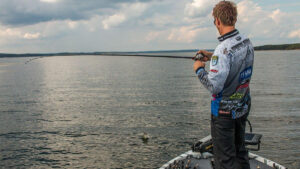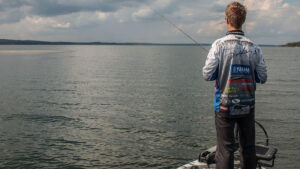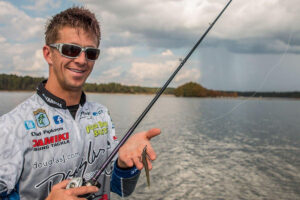It’s not some giant, well-kept secret that bass love aquatic vegetation. It attracts forage, increases oxygen levels in the water and gives them plenty of strategic hiding spots from which they can ambush unsuspecting prey. Grass offers a bass everything it needs to thrive.
There are times, however, when the grass bite can get downright horrible. But don’t assume they’re not in the salad—because more times than not, they haven’t gone anywhere. It might just take a bit of angler ingenuity to trick them into biting.
According to Elite Series pro Chad Pipkens, finesse tactics can pay huge dividends whenever you’re battling slow grass fishing action. Although it goes against the widespread heavy tackle, close combat mentality, downsizing your offering is an effective and often overlooked way to remedy a tough grass bite.
Before you start rigging, there are several important factors to understand about this approach.
- Find the right area
- Finesse is a relative term
- Three rigs you’ll need
The most important question
In order to maximize your finesse fishing success in the grass, it’s important to learn how to detect the most productive areas on a given fishery. Many anglers are overwhelmed by grass fishing because everything seems to look identical, so the first step in this process revolves around finding high-percentage areas.
“When you’re in a virtual sea of vegetation, it can be really difficult to know where to start your dissection,” Pipkens said. “But over the years, I’ve learned that if you can break down an area while taking all of the grass out of the equation, you’ll quickly find bass. Essentially, I’m always asking myself what the fish would be doing if there were absolutely zero grass to be found.”
- Flats can throw you off— Although big, grass-covered flats may seem like an obvious and tempting place to start your search, Pipkens initially avoids them when he’s on an unfamiliar body of water. Because these expansive areas are so difficult to efficiently pick apart, he likens this strategy to “finding a needle in a haystack”. There are probably bass in the vicinity, but without any significant structure to which they can relate, they’ll be dispersed and more difficult to find.
- Contour changes— “I’m going to look for grass adjacent to some sort of contour change,” Pipkens said. “It could be a channel swing, a ditch, a point—anything that sweetens the deal for a bass. If you consider the community holes found on a lot of popular grass lakes, almost every single one is enhanced by a nearby depth change. They’re sought-after fishing spots for a reason.”
- Simple to pattern— When you’re able to find a stretch of grass in close proximity to some sort of structural irregularity, it’s important to pay close attention to the details. For instance, if you get a few key bites on a grass-covered point that drops off into a nearby creek or river channel, there’s an excellent chance that you’ll be able to pattern similar areas throughout the fishery. It only takes a handful of bites to eliminate “dead”, or fishless, water for the rest of the day.
- Tapering out— “It’s angler nature,” Pipkens said. “When most of us see a hard grass line, we head straight for it and start frogging and flipping big baits. But I like to fish the irregularities and find the areas in which the grass line tapers out. These places are often ignored by anglers, so the fish barely get any fishing pressure which makes them much easier to catch. Not to mention, they’re much more accessible with light tackle.”
It’s all relative
Just like most bass fishing terminology, “finesse” is a relative term. For some anglers, it might mean dropping down to 4-pound test to target clearwater smallmouth and for the diehard power fisherman, it might mean using 20-pound fluorocarbon instead of 65-pound braided line.
Finesse fishing grass, however, is somewhere in the middle.
“Think about how most anglers fish grass,” Pipkens said. “They’re punching 1 1/2-ounce weights, heavy jigs and chucking noisy frogs with braided line across the tops of the vegetation. The fish get pounded by these bulky presentations and can absolutely become accustomed to them. I’m not suggesting you break out 8-pound test and a tiny drop shot. But 17-pound fluorocarbon and a 1/2-ounce weight can easily be considered ‘finesse’ in this situation. Very rarely do the bass see that.”
- 1/4 to 5/16-ounce weight— In overcast and breezy conditions, you’ll often find bass relating to the outside edges of the grass in order to feed on nearby forage. In these conditions when grass penetration isn’t a worry, Pipkens most often relies on a 1/4 to 5/16-ounce weight when fishing with both a Texas rig and drop shot. The weightlessness facilitates a very natural presentation which can fool even the most cautious bass.
- 3/8 to 1/2-ounce weight— “When the fish are on the inside of the grass, not quite the middle of it, that’s when I’ll start using a lot of 3/8 or 1/2-ounce weights,” Pipkens said. “It’s all about efficiency in this situation. You need to have enough weight to get your bait to the bottom efficiently. If you’re constantly needing to shake your rod tip to make the bait penetrate the grass, you’re not being efficient. As long as they’re not buried in the thickest part of the cover, these two sizes will do the trick without any issues.”
Finesse option No.1: Lightweight Texas rig
Perhaps no other bass fishing rig has stood the test of time more so than a Texas rig. Many anglers’ earliest catches have been the direct result of an old worm hook, a soft plastic bait and a lead bullet sinker. This proven rig is, in fact, Pipkens’ first choice in regards to finesse fishing grass, but with a modern-day spin.
“If the grass bite is tough, I will always have a 3/8-ounce Texas-rigged Damiki Stinger on 16-pound Sunline Super FC Sniper Fluorocarbon nearby,” Pipkens said. “That’s my old standby and it’s incredibly effective. The Stinger is a small stick worm that penetrates cover easily and I’ll rig it weedless on a 3/0 Gamakastu Heavy Cover Flipping Hook.”
- Tungsten benefits— Pipkens stresses the use of a tungsten weight instead of a traditional lead weight. Tungsten is much denser than lead, which means these weights are much more compact, leading to easier grass penetration and they’re also much more sensitive, which helps you feel even the softest bites.
- Peg your sinker— Like most professional anglers, Pipkens uses a rubber peg to keep his sinker in-place while fishing around grass. In order to effectively penetrate vegetation, he prefers his Texas rig to fall as a single, cohesive unit so it can reach the fish without snags or hang-ups.
- Long casts— “You don’t always have to make short pitches and flips when you’re fishing grass,” Pipkens said. “When the bite is tough, long casts can make a huge difference because you’re not spooking the bass. Additionally, the edges of the grass that you can’t see with your naked eye—where the grass line ends underwater—act as highways for bass. They love to travel and feed along edges, so if you can keep your distance and find where the grass transitions into clean bottom, you’ll likely find a few bass looking for an easy meal. I use a 7-foot, 2-inch 723 Powell Casting Rod because it gives me the ability to bomb a cast and get up-close and personal if need be.”
Finesse option No. 2: Power shot rig
Many of bass anglers are familiar with the drop shot rig—a bass fishing rig in which the weight stays in contact with the bottom while a soft plastic finesse worm subtly dangles, sways and twitches a few inches above.
Pipkens’ second grass fishing finesse option, the power shot rig, is quite similar, but purposely beefed-up in order to minimize heartbreaks when fishing thicker grass.
“When you consider a drop shot, visions of lightweight line and spinning gear probably come to mind,” Pipkens said. “But you can actually beef it up and utilize casting gear and 14-pound Sunline Super FC Sniper Fluorocarbon to make a surprisingly powerful setup.”
- A different look— Much like its “little brother”, the power shot excels at producing bites from ultra-finicky bass. Instead of the bait being buried in the grass, this rig allows the bait to be off the bottom and above much of the vegetation, increasing visibility for the bass. Pipkens primarily uses a 6-inch leader when fishing around grass. That may seem short, but it doesn’t take much to pique a bass’ curiosity. Again, it’s all about showing them something they’re not accustomed to seeing.
- Excellent hookup ratio— “If I can make the bass eat this rig, I actually prefer it over a traditional Texas rig,” Pipkens said. “The hookup ratio is absolutely incredibly because the weight doesn’t get anywhere near the bass’ mouth—it’s all hook. This allows me to Texas rig the bait onto a 3/0 Gamakatsu Finesse Heavy Cover Hook and have full confidence that I’m going to connect on each and every hookset.”
Finesse option No. 3: Drop shot rig on spinning tackle
If all else fails, Pipkens isn’t afraid to result to a finesse drop shot rig on spinning tackle. Although it’s not his primary choice when dissecting grass, he believes it’s an excellent way to save an otherwise subpar day of fishing.
“This rig is as natural as you can possibly get,” Pipkens said. “I’ll use 12-pound Sunline FX2 Braided Line as my main line, attached to a 10-pound Sunline Super FC Sniper leader and believe it or not, it gives you a surprising amount of power for such a finesse technique. That braid is very important because it cuts through the grass like a knife and has absolutely zero stretch, allowing me to get a quick hookset and get ‘em out of the grass before they wrap me up.”
- If you’re convinced— At some point in time, we’ve all fished areas that simply looked “too good” to not have a bass on them. According to Pipkens, these situations are tailor-made for a finesse drop shot rig. He’s able to “soak” his bait in one small area for an extended period of time, giving nearby bass plenty of time to eat it. If he believes there are fish nearby, he has full confidence that they’ll eventually bite this rig.
- Best for edges— “You won’t be penetrating much cover with this setup,” Pipkens said. “I use a 1/4-ounce weight with a Poor Boy’s DS Darter rigged on a 1/0 Gamakatsu Offset Round Bend Worm Hook, so I’m not looking to target the thick stuff. Instead, I’ll concentrate on the outside grass lines and the first few feet of the grass itself. You’ll have the best luck if you use this rig as your target-casting setup.”
If you can’t quite seem to get the grass bite going this year, don’t hesitate to put away the heavy artillery in favor of these proven finesse rigs. It may take a few bites to gain some confidence, but you’ll enjoy a lot of bonus fish catches if you can stick with it and utilize Pipkens’ advice.















